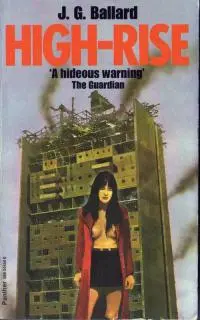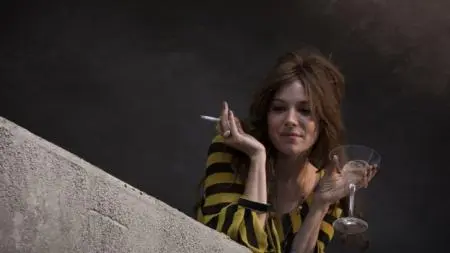WARNING: SPOILERS AHEAD
The main storyline of J.G. Ballard's 1975 novel, High-Rise, remains relatively unchanged in Ben Wheatley’s film: Dr. Robert Laing, a physiology professor, moves into a luxury high-rise apartment, and as the amenities begin to fail, the social structure of the building deteriorates and a class war ensues. The lower floors are for the lower class residents, which in this vertical society are still decidedly upper middle class. The societal class increases with the floor level, and as the high-rise deteriorates, so do the residents; they grow to resent each other, their actions escalating from petty arguments to withholding resources to theft, rape, cannibalism, and murder.
The film begins much in the same way, with Laing, portrayed by Tom Hiddleston, on his 25th floor balcony, roasting a dog, setting up a flashback to three months prior when the conflict began. Some changes are to be expected in an adaptation: events take place at a quicker pace, minor characters are thrown out or combined into one to help move the plot along and tighten the narrative. But the major differences between the book and film stem from character changes and storytelling differences.
CHARACTERS
Robert Laing (Tom Hiddleston) narrates the film in the 3rd person, directly quoting Ballard’s text at times. Laing’s clinical, removed tone serves the film well, furthering the contrast between the horrific events occurring in the high-rise and their calm, matter-of-fact descriptions in the novel. The biggest alteration to Laing’s character is due to the lack of his sister, Alice, in the film's storyline. In the book, Alice is present throughout and ends up living with Laing and another woman, Eleanor, at the end of the storyline. In the film, she has recently died and is mentioned multiple times. Charlotte enquires about her when Laing is mid-thrust during their first sexual encounter, which is fitting, since Laing and Alice’s relationship borders on incest multiple times in the novel.
Richard Wilder (Luke Evans), a television producer, is the most visceral character in both versions. The film does, however, present a more composed Wilder: his documentary and quest for the 40th floor aren't as all-encompassing, he isn't as quick to completely abandon his family, and he doesn't devolve quite as far into caveman mentality as he does in the novel. Still, Luke Evans's portrays Wilder with a barely contained tension and violence that is fascinating to watch.
Charlotte Melville (Sienna Miller) plays a much larger role in the film than she does in the novel. Instead of showing up sporadically and having a one night stand with Laing, she and her son, Toby, feature in the film heavily, resulting in more of a relationship with Laing. The film also reveals that Anthony Royal, the architect of the high-rise, is Toby’s father, creating a minor plot line that feels forced.
Anthony Royal (Jeremy Irons) has a much stronger physical presence in the film than he does in the novel; people interact with him and he does not seem to be quite so confined to the 40th floor of the high-rise. He is more violent and less enigmatic. Instead of neglecting to cancel squash with Laing, causing him to walk in on the upper level party at the beginning of the novel, Royal openly invites him. At this party, Laing runs into one of his students, Munrow, and is deeply embarrassed.
Prior to Royal’s party in the film, Munrow (Augustus Prew) faints in class as Laing pulls the face off of the skull of a decapitated head: “As you can see, the facial mask simply slips off the skull.” As it turns out, Munrow lives in the high-rise and is the one to jump off the building, committing suicide, instead of the older jeweler mysteriously falling from the building as in the novel. The jeweler’s wife is also missing from the story, and in her absence, a mother mentions her daughter being sexually assaulted in the elevator instead.
PLOT
One of the most striking differences between the book and film lies in its representation of sex in the high-rise. As the book progresses, sex is most commonly presented as either an assault or an impersonal transaction. The film puts passion back into the sexual aspects of the story, but, in doing so, weakens one of the most disturbing parts of the novel: the complete vacancy of emotion and lack of communication.
In the book, Laing views his sexual encounter with Charlotte as an end to any future relationship that may have developed; the film morphs their relationship into a passionate, domestic one. The film is interspersed with shots of orgies and even the architect himself, Royal, is given a new sexual background: he is now the father of Charlotte Melville’s child, Toby.
One of the most disturbing scenes in the novel is when Wilder records himself violently sexually assaulting Charlotte, after which they eat breakfast together, “sitting at the table with an incongruous old-world formality” and Charlotte sits “unconcerned, watching Wilder with a passive expression.” The film does show Wilder dragging a struggling Charlotte into another room and makes it clear that a consensual act is not about to occur, but the equally as disturbing aftermath is missing.
In a similar vein, Royal makes a sexual advance on Helen Wilder (Elizabeth Moss) near the end of the novel and she responds by simply moving his hands to her waist because “she had been molested by so many men during the past months, but also because the sexual assault itself had ceased to have any meaning.” Instead, the film adds in a scene in which Laing has sex with an enthusiastic, pregnant Helen Wilder simply because she is in his flat. The sexual politics in both the film and novel are of course disturbing, but the film has diluted the events going on in the high-rise, diminishing the impact of these moments.
 While the film is visually striking and boasts several stand out performances (particularly Luke Evans as Wilder), Ballard’s unsettling, “malevolent zoo” has become more of a sinister petting zoo. Both versions have an air of unease and fragile restraint, but the film views like a more socially acceptable version of the novel. Laing, while still unhinged, has a bit of his conscience left: he intervenes when a man is being beaten rather than simply standing and watching. Laing’s borderline incestuous relationship with his sister, Alice, is erased due to her absence in the film. While he still races to get back to the high-rise any time he leaves, the sense that he is leaving “part of his mind behind him” every time he exits the building is missing. Instead of Royal dragging himself down multiple floors to the corpse pool, Laing brings his body there and lays him to rest in the watery mass grave. Even though the film does feature roast Alsatian, there is considerably less animal cruelty in the film than the book. Wilder’s crazed attempt to reach the 40th floor is instead a visit to Royal’s housekeeper, in which he demands her key, and reaches the top floor without much difficulty. The presence of sexual assault has been diminished in the film and the audience gets to see the women on the top floor murder the misogynistic Wilder.
While the film is visually striking and boasts several stand out performances (particularly Luke Evans as Wilder), Ballard’s unsettling, “malevolent zoo” has become more of a sinister petting zoo. Both versions have an air of unease and fragile restraint, but the film views like a more socially acceptable version of the novel. Laing, while still unhinged, has a bit of his conscience left: he intervenes when a man is being beaten rather than simply standing and watching. Laing’s borderline incestuous relationship with his sister, Alice, is erased due to her absence in the film. While he still races to get back to the high-rise any time he leaves, the sense that he is leaving “part of his mind behind him” every time he exits the building is missing. Instead of Royal dragging himself down multiple floors to the corpse pool, Laing brings his body there and lays him to rest in the watery mass grave. Even though the film does feature roast Alsatian, there is considerably less animal cruelty in the film than the book. Wilder’s crazed attempt to reach the 40th floor is instead a visit to Royal’s housekeeper, in which he demands her key, and reaches the top floor without much difficulty. The presence of sexual assault has been diminished in the film and the audience gets to see the women on the top floor murder the misogynistic Wilder.
Unfortunately, the film didn’t find a way to reconcile why the hell the high-rise’s employees (pool attendant, supermarket cashier, maintenance, etc…) are still working there.
The novel ends with Laing cohabitating with his sister and Eleanor, eating the Alsatian, looking out at the other high-rise where “already torch-beams were moving in the darkness, as the residents made their first confused attempts to discover who they were. Laing watched them contentedly, ready to welcome them to their new world.” The film, instead, features Laing and Charlotte living together, in a sort of twisted, traditionally comedic dramatic ending. As the camera pans out, the audience sees Toby listening to his headphones as Margaret Thatcher hails capitalism.
VERDICT
Ben Wheatley’s film is a decent adaptation, even if it falls short of capturing the intrinsic tension present in Ballard’s novel: there are better adaptations and there are worse. The film features solid performances, gorgeous cinematography, and stylish storytelling, managing to present most of the same social and psychological issues as the novel. The two versions coexist well together and independently, though I will admit, I do think the plot is better suited to a print medium.

About the author
Emily has a Master's degree in early modern literature and drama from King's College London and a Bachelor's in English from the University of Iowa. In addition to being a social media manager, she is a writer and theatre practitioner.








